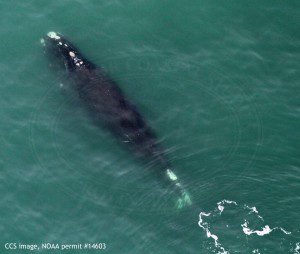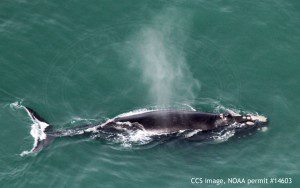March 2015
March 06, 2015: After a snowfall on Thursday we weren’t sure if we could fly, but the the sun and the plowing skills of the staff of Chatham Airport and Department of Public Works did a great job, and when we arrived we saw a perfectly clean runway.
The beginning of the flight was promising as we flew the Bay south to north although the southeastern portion of the Bay was covered with dense pancake ice. On the second trackline, we found our first pair of right whales, and another five (in pairs and as singles) were detected on the next three tracks. All whales we found in the Bay that day were concentrated in its south-central part. A couple of the whales were well-known, easily recognizable individuals: EgNo2360 “Derecha” and EgNo1280 “Luna”.

Right whale EgNo1280, Luna. Note the white scarring on the peduncle from an earlier entanglement. CCS image, NOAA permit #14603.
Derecha was first sighted at an unknown age in the early 90s but not seen in Cape Cod Bay until 2011; she is a breeding female who last calved in 2010. Luna (age and sex unknown) has been seen since the early 80s and is a regular visitor to Cape Cod Bay; a good portion of its sighting history has come from time spent in and around the Bay. Luna was sighted last year in the Bay with new and significant injuries, and while the animal was not carrying any gear it is likely that these came from an entanglement which occurred within the last year. We are very glad to see that Luna’s wounds appear to be healing.
On the northern lines we encountered a large fin whale swimming just subsurface. The last right whale of the day signaled us with a blow when we were flying along the outer side of Cape Cod.
March 20, 2015: This was our first flight since our plane underwent scheduled maintenance. We were excited to see who would be in the bay and what they were doing after this recess, and took off in the Skymaster with low winds and calm sea states. It was a beautiful day so a number of researchers from other organizations were flying their own aerial surveys in area outside the Bay. The Center’s right whale habitat crew aboard the R/V Shearwater was also out on the water.
To our surprise, we only saw one right whale, and the footprint of another. This whale was EgNo1033, a male who is at least 36 years old; he has been studied in CCB since 1985 and was last seen by our survey team in May 2014. We are now wondering how the remainder of the season will be in regards to the demographics of individuals and numbers.
March 25, 2015 – Morning: The CCS right whale team took excellent advantage of this short weather window and conducted back to back aerial surveys of the eastern outer shore and Cape Cod Bay.
The first flight, east of the Outer Cape, was flown north to south, and within a few track lines more activity and oceanographic changes were observed than on previous flights. Two right whales were sighted but their dives were almost 20 minutes exactly and difficult to photograph. Three fin whales and three minke whales were also spotted, a nice change since we haven’t sighted many lately. Plankton was visible in coastal areas and close to Provincetown – an encouraging sign that the season may in fact pick up to a level more in line with previous ones. We finished around noon to refuel for the next survey.
March 25, 2015 – Afternoon: After a short break to refuel, we took off for the Cape Cod Bay survey. One fin whale was sighted from the trackline. The increased amount of wildlife observed on the marning’s eastern outer shore survey suggested that we might finally see the long expected change in the right whale presence in the Bay, and right on our first trackline we spotted a whale! The plane circled for close to half an hour waiting for the right whale to resurface in hopes of documenting this individual, only to watch the animal fluke and dive again: we did not have a chance to take a single photo. Because we were still at the very beginning of the survey we did not wait for the next surfacing and left this whale, hoping we would spot it when we return past this area finishing the next line.
On the next line a whale that couldn’t be identified from the trackline was sighted, so we circled, waiting for it to surface – only to realize it was not a right whale, but another fin whale. This fin whale had a prominent scar, and we showed a picture of it to our colleagues at The Center who work with fin whales, they were able to immediately recognize it.
The rest of the bay was empty, with not a single other marine mammal seen. Quite disappointing after so much effort put, but hope never dies. We’ll wait.
March 31, 2015: This Tuesday, the last day of March, spring was finally in the air, with little snow left on the ground and birds singing everywhere. Winds were high in the morning but an afternoon takeoff saw ideal survey conditions. Unfortunately we had no right whales or marine mammals of any kind in Cape Cod Bay. On the bright side we knew we weren’t missing any on the surface, as we could see clearly across track lines in this calm clear weather. The highlight of the day was seeing the boat named Half Moon, a replica of a Dutch 17th century vessel, cross our path and give us a salute.
Once we turned onto the backside we saw two fin whales and one right whale; EgNo 3670, a female born in 2006. She was previously sighted with severe trauma due to an entanglement and still carries disheartening wounds. If she is able to survive, this young whale will hopefully become a reproducing female and contribute to the recovery of the species. The sea state picked up shortly after but conditions were good enough to complete the survey.

Our Work
Humpback Whale Research
Right Whale Research
Marine Animal Entanglement Response
Marine Geology Department
Water Quality Monitoring Program
Marine Fisheries Research
Seal Research
Shark Research
Marine Education
Interdisciplinary
Marine Debris and Plastics Program
Marine Policy Initiative
Cape Cod Climate Change Collaborative
Publications



